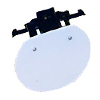Newbie22
Member
Recently I've been trying to learn how to shoot with both eyes open. The trouble I'm having is that nobody has told me which image I should be focusing on when I shoot, the front sight or the target. I know in normal one-eyed shooting one always focuses on the front sight, but I also know that when shooting with a red dot one should focus on the target and let their brain naturally pick out the dot and put it on target.
Basically, should I be focusing on the front sight and dealing with two targets downrange, or should I focus on the target and learn to deal with two front sights?
Also, I did try doing a search beforehand. I found old threads regarding shooting with both eyes open, but none of them answered my question.
Thanks,
Newbie
Basically, should I be focusing on the front sight and dealing with two targets downrange, or should I focus on the target and learn to deal with two front sights?
Also, I did try doing a search beforehand. I found old threads regarding shooting with both eyes open, but none of them answered my question.
Thanks,
Newbie


